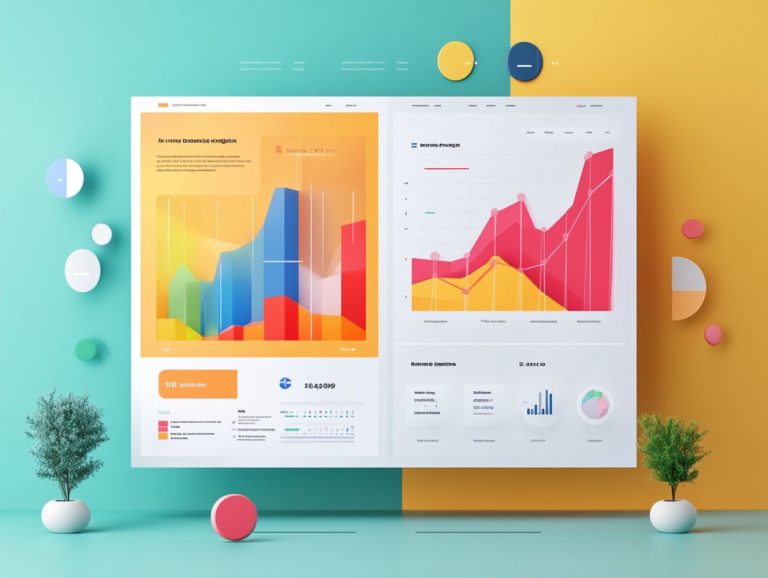Understanding Organic vs. Paid Traffic Sources
In the ever-evolving digital landscape, driving traffic to your website is essential for growth. Wondering how to choose between organic and paid traffic for your website? Each option offers unique benefits and challenges.
This article delves into the advantages of organic traffic, highlighting sustainable results and quality engagement. We will also examine the immediate reach and targeting capabilities of paid options. You’ll learn how to find the best fit for your business and discover strategies for maximizing their effectiveness together.
Get ready to discover the winning strategy for your success today!
Contents
- Key Takeaways:
- Benefits of Organic Traffic
- Benefits of Paid Traffic
- How to Determine the Best Traffic Source for Your Business
- Maximizing the Effectiveness of Both Traffic Sources
- Frequently Asked Questions
- What is the difference between organic and paid traffic sources?
- Which traffic source is better for my website – organic or paid?
- How can I increase my organic traffic?
- What are the advantages of paid traffic?
- Is it better to focus on organic or paid traffic for my business?
- Can I use a combination of organic and paid traffic for my website?
Key Takeaways:
- Organic traffic delivers lasting, high-quality results that outshine paid options.
- Paid traffic offers targeted reach and immediate results, making it great for short-term campaigns.
- When determining the best traffic source for your business, consider budget, goals, and target audience.
What are Organic and Paid Traffic Sources?
Organic and paid traffic sources are essential pathways for drawing visitors to your online presence, each offering distinct advantages and strategies tailored to your goals. Organic traffic comes from search engines like Google and Bing, where high-quality content and effective SEO (Search Engine Optimization) strategies elevate your visibility. In contrast, paid traffic encompasses methods such as PPC (Pay-Per-Click) and social media ads, allowing you to launch targeted campaigns that deliver immediate results. Understanding these traffic categories is crucial for optimizing your marketing spend and achieving a higher return on investment (ROI).
While organic traffic demands time and consistent effort through content creation and optimization, it serves as a long-term strategy that builds credibility and trust over time. Common sources of organic traffic include:
- Blog articles
- Social shares
- Referral links
On the flip side, paid traffic can provide rapid visibility and audience reach, but it requires a budget and ongoing management. Platforms like Google Ads and Facebook Ads are popular choices for driving paid traffic. Both organic and paid traffic can be effectively monitored using tools like Google Analytics, which enables you to evaluate user behavior and traffic sources.
Incorporating well-researched keywords into your SEO efforts is vital as they attract the right audience and significantly enhance your chances of successful conversions.
Benefits of Organic Traffic
Organic traffic presents a wealth of advantages, chiefly due to its capacity to deliver high-quality leads and sustainable outcomes that often surpass the effectiveness of paid campaigns over time.
By honing in on superior content creation and implementing effective SEO strategies, you can significantly enhance your website s optimization. This will naturally lead to higher engagement rates and improved traffic metrics.
This approach minimizes your marketing expenses and fosters an audience that values real interactions with your brand.
Higher Quality and Sustainable Results
Higher quality and sustainable results define organic traffic, stemming from a consistent effort to deliver high-quality content that aligns with user intent. By implementing effective SEO strategies, you can establish a solid foundation for attracting and retaining valuable leads over time.
This approach enhances your visibility and builds your credibility, as users are more inclined to engage with content they find informative and relevant. For example, a brand that consistently publishes comprehensive guides and how-to articles often witnesses a boost in organic engagement, translating into improved search rankings.
Imagine a website that optimized its blog posts with targeted keywords, infographics, and current statistics. Over time, it experienced a remarkable rise in traffic and cultivated a loyal readership. These examples underscore the importance of prioritizing content quality and relevance to forge lasting connections with your audience, ultimately driving sustainable growth.
Start optimizing your traffic sources today and watch your business grow!
Benefits of Paid Traffic
Paid traffic is an invaluable asset, especially if you want targeted reach and instant results. It lets you connect with potential customers quickly and effectively!
With Pay-Per-Click (PPC) advertising a method where you pay for each click on your ad and social media ad campaigns, you can allocate your budget strategically. This maximizes conversion rates and improves campaign performance.
This method provides essential traffic insights. You can refine your marketing strategies, leading to a higher return on investment (ROI).
Targeted Reach and Immediate Results
Targeted reach and immediate results are significant advantages of paid traffic. They help you connect with specific audiences based on demographics and interests.
Consider audience segmentation as a vital part of your marketing strategy. This involves dividing your audience into smaller groups for targeted messaging. By breaking down your market based on behaviors or preferences, you can tailor your messaging to resonate more profoundly with each group!
Employing dynamic remarketing tactics allows you to re-engage potential customers who have previously interacted with your brand. This maximizes your return on investment. By taking these steps, you can achieve immediate and meaningful results from your paid campaigns.
How to Determine the Best Traffic Source for Your Business
Determining the optimal traffic source for your business requires a strategic analysis of several key factors, including your target audience, budget, and marketing objectives.
By assessing the division of traffic between organic and paid channels, you can uncover valuable insights into which sources deliver the highest conversion rates and resonate most effectively with your audience.
Leveraging advanced website analytics tools, such as Google Analytics, will enhance your understanding of traffic categories, enabling you to make informed decisions regarding your marketing investments.
Factors to Consider
Several factors warrant your attention when determining the optimal traffic source for your business, including your marketing goals, audience targeting, and conversion rates. Grasping the balance between paid search traffic and organic reach enables you to make more strategic decisions.
By aligning your traffic sources with specific objectives, you can significantly enhance your overall effectiveness. For instance, if you’re aiming for immediate sales, you might discover that paid search campaigns yield quicker results. Conversely, if your focus is on long-term brand awareness, content marketing and organic strategies could serve you better.
Research shows that businesses effectively leveraging SEO can achieve up to 14 times more conversions compared to relying solely on paid ads. Audience demographics play a pivotal role; by utilizing analytical tools, you can ascertain whether a younger audience gravitates toward social media platforms or if an older demographic engages more effectively through email newsletters.
In essence, adopting a tailored approach will markedly enhance your decision-making regarding traffic source selection.
Maximizing the Effectiveness of Both Traffic Sources
Maximizing the effectiveness of both organic and paid traffic sources demands a sophisticated strategy that harmonizes the strengths of each channel. By seamlessly integrating effective SEO strategies with your PPC campaigns, you can cultivate a diversified approach that enhances audience engagement and drives sustainable traffic growth!
This synergy optimizes your resource investment while leveraging traffic insights to refine your content creation efforts, ultimately leading to improved overall performance.
Strategies for Combining Organic and Paid Traffic
Integrating organic and paid traffic strategies can elevate your marketing effectiveness and boost brand visibility. By using content marketing techniques with paid campaigns, you gain valuable traffic insights and enhance your reach.
Leveraging the strengths of both approaches creates a powerful effect that amplifies your message across various platforms. For instance, when you find content that resonates with your audience through paid promotions, you can adjust your organic strategy to align with these insights. This ensures your messaging stays cohesive and targeted.
Utilizing data from your paid campaigns helps you identify which organic content performs best, allowing for more strategic resource allocation for maximum impact. This combination helps you build a loyal customer base and encourages sustainable growth over time.
Choosing the Right Traffic Source for Your Goals
Selecting the right traffic source for your marketing goals requires careful assessment of your objectives. Whether you want to maximize organic reach or prefer the immediacy of paid search traffic, aligning your traffic sources with your audience’s specific needs can significantly enhance your conversion rates. This strategic alignment lets you focus on channels that deliver the best return on investment (ROI).
If you’re aiming to build brand awareness, prioritize organic traffic by creating engaging content and using social media strategies that foster a community around your brand. Conversely, if your focus is on lead generation, paid advertisements may serve you better, facilitating quick interactions and enabling targeted outreach.
For example, a tech startup effectively used paid ads on social platforms to generate leads quickly, while an established clothing brand concentrated on SEO to enhance its organic visibility. This illustrates how different objectives require tailored approaches.
Ultimately, weighing the pros and cons of each traffic source helps you optimize your strategies based on your unique goals.
Check out this video for more insights on blending organic and paid traffic strategies!
Frequently Asked Questions
What is the difference between organic and paid traffic sources?
Organic traffic refers to visitors coming from unpaid, natural search engine results. Paid traffic refers to visitors coming from paid advertisements like Google Ads or social media ads.
Which traffic source is better for my website – organic or paid?
Your choice depends on your goals and budget. Organic traffic offers long-term benefits as a sustainable source, while paid traffic delivers immediate results and can target specific audiences. Both are essential for a well-rounded marketing strategy.
How can I increase my organic traffic?
To boost organic traffic, focus on search engine optimization (SEO), which means improving your site to appear higher in search results. This includes creating high-quality content, using relevant keywords, and building backlinks. Regularly updating your website and ensuring it’s user-friendly can also help.
What are the advantages of paid traffic?
Paid traffic allows you to control who sees your ads by targeting specific demographics and interests. This can lead to higher conversion rates and better ROI. Additionally, paid traffic provides immediate results, making it ideal for short-term goals.
Is it better to focus on organic or paid traffic for my business?
Your focus should depend on your industry and goals. Some businesses benefit more from organic traffic, while others achieve better results with paid traffic. Analyze your target audience and budget to find the best approach for your specific business.
Can I use a combination of organic and paid traffic for my website?
Absolutely! Using a blend of organic and paid traffic often yields the best results. Organic traffic builds your website’s authority for long-term success, while paid traffic provides immediate results. Finding a balance that works for you and adjusting your strategy as needed is key.
Start blending your strategies today for the best results!





